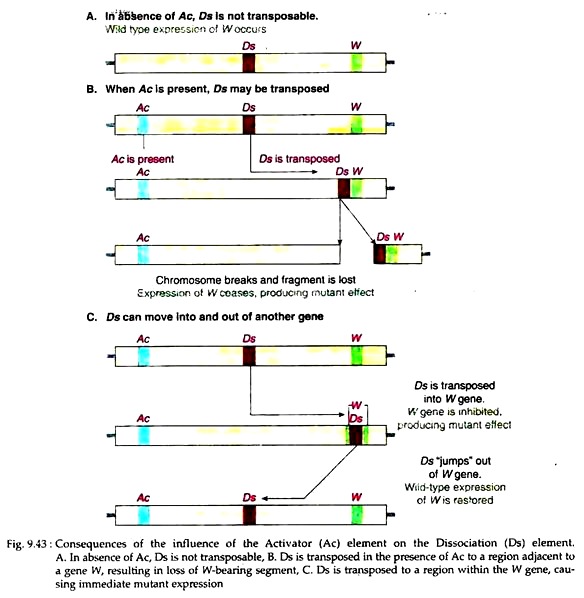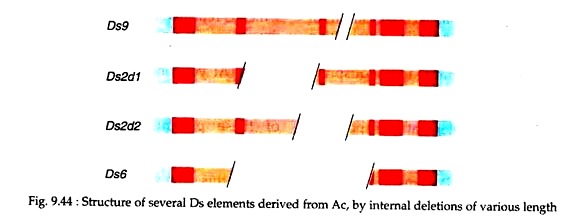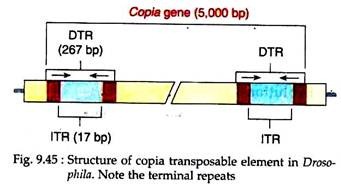In this article we will discuss about the transposable elements in maize, peas and drosophila plants.
Transposable Elements in Maize Plants:
Several families of transposons were identified in corn. In each family there exist two forms of transposon:
(i) Autonomous elements that can transpose by themselves and
(ii) Non-autonomous elements that cannot transpose by themselves because of lacking the gene for transposition.
ADVERTISEMENTS:
The autonomous element results in unstable mutant allele following its insertion into host gene, because it can excise and transpose a new location. By contrast, non-autonomous element results in stable mutant allele after its insertion in a host gene, since this element is unable to transpose out of locus by itself.
The Ac-Ds system in Maize:
Barbara McClintock reported an interesting type of chromosomal behaviour causing a variety of phenotypic effects in maize. She observed that the chromosome 9 was always broken at the same place during development. She called the unstable chromosome site as Ds or dissociation, because the most recognisable consequence of its action was dissociation.
She also observed that Ds locus would undergo dissociation mutations only when a particular dominant factor was present. Barbara named that factor as activator or Ac, because it activated chromosome breakage at Ds. Subsequent analysis by McClintock revealed that both the Ds and Ac genes were sometimes transposed to different chromosomal locations.
ADVERTISEMENTS:
As is capable of autonomous movement, while Ds moves only if Ac is present. Where Ds comes to reside, it might cause chromosome breakage or it might inhibit gene expression. In cells, where expression is inhibited, Ds might move again, releasing this inhibition. In such cases, Ds element is believed to insert into a gene and subsequently to depart from it, causing changes in gene expression.
In McClintock’s original observation, when Ds element jumped out of chromosome 9, this excision event restored normal gene function. In such cells, pigment synthesis was restored (Fig. 9.43). McClintock concluded that both Ds and Ac genes are transposable controlling elements.
Several Ac and Ds elements have now been isolated and analysed. All Ds elements have the same terminal IRs as Ac elements and many of these Ds elements have been generated from Ac by deletion of various lengths (e.g., Ds 9, Ds 2d1, Ds 2d2, Ds6) (Fig. 9.44) .
ADVERTISEMENTS:
In corn, both the timing and frequency of transposition of Ac and Ds elements as well as the genetic rearrangements associated with the elements are developmentally regulated. This is the unique property of corn transposons.
Transposable Elements in Peas Plant:
More recent work on transposable elements indicated that the wrinkled phenotype in peas as observed by Mendel during his hybridisation experiment was due to the absence of an enzyme Starch-branching enzyme (SBEI) that controls the formation of branch points in starch molecules. As the pea seeds mature, the wrinkled seed (genotype rr) lose more water than do the smooth seeds (RR or Rr genotype) producing wrinkled phenotype.
In rr genotype, the SBEI protein is nonfunctional, presumably it is interrupted by a 0.8 kb insertion, resulting in the production of an abnormal RNA transcript. The inserted DNA has 12 bp inverted repeats at each end that are very much homologous to the terminal sequences in the transposable element Ac from maize to other Ac-like elements from snapdragons and parsley. Thus, terminal repeated sequences and gene encoding transposase, appear to be universal components of transposons in all plant species studied.
Transposable Elements in Drosophila Plants:
Copia Element:
In the fruit-fly Drosophila, a remarkable percentage (about 15 percent) of its genome is mobile. In 1975, D. Hogness and his colleagues D. Finnegan, and G. Rubin, identified genes in Drosophila that transcribe “copious” amount of RNA.
These genes were referred to as ‘copia’ and are almost similar in their nucleotide sequences in all cases. Subsequent studies confirmed that ‘copia’ are transposable and dispersed throughout the genome of Drosophila.
Each copia element consists of approximately 5000 to 8000 bp of DNA, including a long family- specific direct terminal repeat (DTR) sequence of 276 bp at each end. Within each repeat is a short inverted terminal repeat (ITR) of 17 bp (Fig. 9.45). The shorter ITR sequences are found to be universal in copia elements but the DTR sequences are not so as these are found to occur in transposons of other organisms.
Like other transposons, the insertion of copia element is dependent on ITR sequences and occurs at specific target sites in the genome. Their insertion may cause some mutations, including one affecting eye colour and segment formation in Drosophila. For example, the eye colour mutant white apricot (Wa), an allele of the white (w) gene, contains a copia insertion element within the gene. Removing the transposable element sometimes restores the wild type allele.
ADVERTISEMENTS:
P element:
Another interesting transposable element found in Drosophila is P element. P element are 2.9 kb long, with 31 bp terminal inverted repeats. It encodes at least two proteins, one is transposase and the other is a repressor protein.
The transposase is expressed only in the germ line, accounting for the tissue specificity of P element transposition. Strains of flies that contain P elements inserted into their genome are further resistant to transposition due to the activity of the repressor protein.
It has been found that in certain strains of Drosophila, hybrid dysgenesis, a condition causing sterility, elevated mutation fate and chromosome rearrangement in the offspring is caused by high rates of P element transposition in the germ line. Various elegant techniques, based on P element transposition, have been developed.
For example, gene’s activity and expression pattern could be studied by P element. P element provides a vehicle or vector for inserting a cloned gene into a fly’s genome. In this case, embryos are injected with a mixture of P elements. One contains the transposase gene (but cannot insert) and the other contains the marker gene and the cloned gene of interest, but lacks a transposase.
Flies that have been transformed are selected on the basis of the marker gene-phenotype and, thus, the behaviour of the cloned and transposed gene can be observed. Besides, recently methods have been developed to target P element insertions to precise single-chromosomal sites. It will increase the precision of germ line transformation in the analysis of gene activity. It is also used as insertional mutagens in Drosophila.


